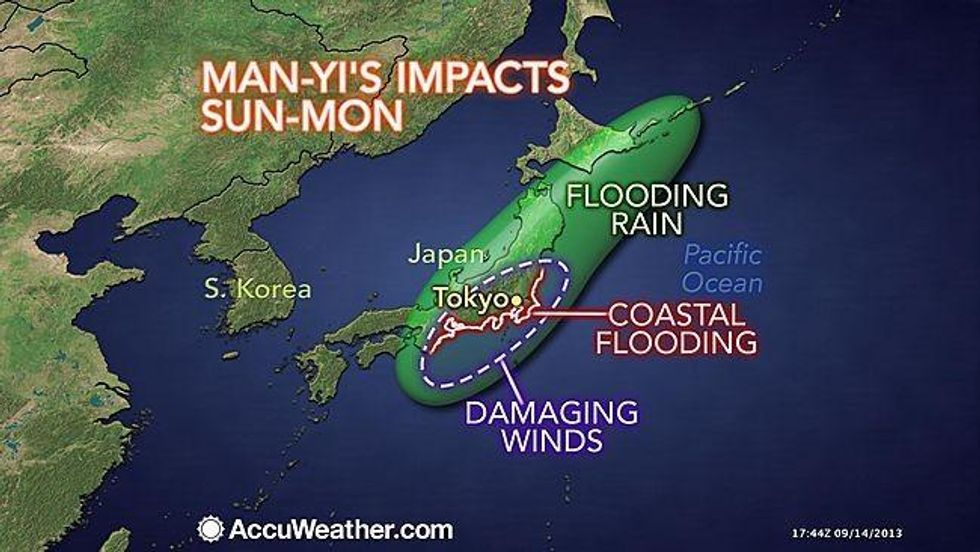Sep 16, 2013

Ahead of the storm's landfall, fears were that high winds and rising waters could further destabilize the crippled Fukushima Daiichi plant, which sits on the coast northeast of Tokyo.
Though the storm battered southern prefectures of the island nation, sparking flash floods and mudslides in Saitama, Fukui, and Kyoto--Fukushima did not take a direct hit as was feared over the weekend.
However, as heavy rains continued throughout the day, the water storage areas that blanket the area around the Fukushima plant came under threat.
And as Channel NewsAsia reports:
[TEPCO] workers were pumping out water from areas near tanks storing radioactive water, from which leaks are believed to have seeped into groundwater.
"But we decided to release the water into sea as we reached a conclusion that it can be regarded as rainfall after we monitored levels of radiation," TEPCO spokesman Yo Koshimizu said.
According to the spokesman, one litre of the water contained up to 24 becquerels of strontium and other radioactive materials -- below the 30 becquerel per litre safety limit imposed by Japanese authorities for a possible release to the environment.
However, it was unknown how much water was released to sea under the "emergency measure," Koshimizu said.
_______________________________________________
An Unconstitutional Rampage
Trump and Musk are on an unconstitutional rampage, aiming for virtually every corner of the federal government. These two right-wing billionaires are targeting nurses, scientists, teachers, daycare providers, judges, veterans, air traffic controllers, and nuclear safety inspectors. No one is safe. The food stamps program, Social Security, Medicare, and Medicaid are next. It’s an unprecedented disaster and a five-alarm fire, but there will be a reckoning. The people did not vote for this. The American people do not want this dystopian hellscape that hides behind claims of “efficiency.” Still, in reality, it is all a giveaway to corporate interests and the libertarian dreams of far-right oligarchs like Musk. Common Dreams is playing a vital role by reporting day and night on this orgy of corruption and greed, as well as what everyday people can do to organize and fight back. As a people-powered nonprofit news outlet, we cover issues the corporate media never will, but we can only continue with our readers’ support. |
Our work is licensed under Creative Commons (CC BY-NC-ND 3.0). Feel free to republish and share widely.

Ahead of the storm's landfall, fears were that high winds and rising waters could further destabilize the crippled Fukushima Daiichi plant, which sits on the coast northeast of Tokyo.
Though the storm battered southern prefectures of the island nation, sparking flash floods and mudslides in Saitama, Fukui, and Kyoto--Fukushima did not take a direct hit as was feared over the weekend.
However, as heavy rains continued throughout the day, the water storage areas that blanket the area around the Fukushima plant came under threat.
And as Channel NewsAsia reports:
[TEPCO] workers were pumping out water from areas near tanks storing radioactive water, from which leaks are believed to have seeped into groundwater.
"But we decided to release the water into sea as we reached a conclusion that it can be regarded as rainfall after we monitored levels of radiation," TEPCO spokesman Yo Koshimizu said.
According to the spokesman, one litre of the water contained up to 24 becquerels of strontium and other radioactive materials -- below the 30 becquerel per litre safety limit imposed by Japanese authorities for a possible release to the environment.
However, it was unknown how much water was released to sea under the "emergency measure," Koshimizu said.
_______________________________________________

Ahead of the storm's landfall, fears were that high winds and rising waters could further destabilize the crippled Fukushima Daiichi plant, which sits on the coast northeast of Tokyo.
Though the storm battered southern prefectures of the island nation, sparking flash floods and mudslides in Saitama, Fukui, and Kyoto--Fukushima did not take a direct hit as was feared over the weekend.
However, as heavy rains continued throughout the day, the water storage areas that blanket the area around the Fukushima plant came under threat.
And as Channel NewsAsia reports:
[TEPCO] workers were pumping out water from areas near tanks storing radioactive water, from which leaks are believed to have seeped into groundwater.
"But we decided to release the water into sea as we reached a conclusion that it can be regarded as rainfall after we monitored levels of radiation," TEPCO spokesman Yo Koshimizu said.
According to the spokesman, one litre of the water contained up to 24 becquerels of strontium and other radioactive materials -- below the 30 becquerel per litre safety limit imposed by Japanese authorities for a possible release to the environment.
However, it was unknown how much water was released to sea under the "emergency measure," Koshimizu said.
_______________________________________________
We've had enough. The 1% own and operate the corporate media. They are doing everything they can to defend the status quo, squash dissent and protect the wealthy and the powerful. The Common Dreams media model is different. We cover the news that matters to the 99%. Our mission? To inform. To inspire. To ignite change for the common good. How? Nonprofit. Independent. Reader-supported. Free to read. Free to republish. Free to share. With no advertising. No paywalls. No selling of your data. Thousands of small donations fund our newsroom and allow us to continue publishing. Can you chip in? We can't do it without you. Thank you.